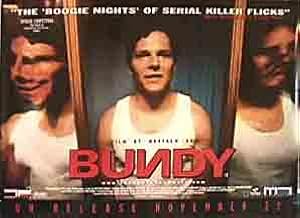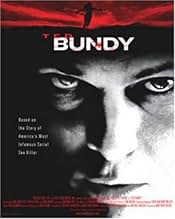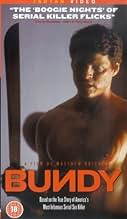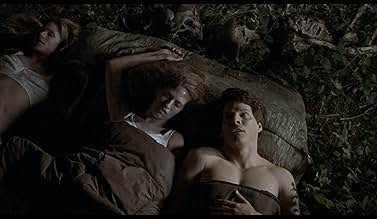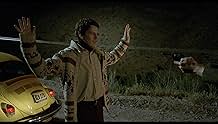NOTE IMDb
5,8/10
8,5 k
MA NOTE
Ajouter une intrigue dans votre langueThe story of serial killer Ted Bundy.The story of serial killer Ted Bundy.The story of serial killer Ted Bundy.
- Réalisation
- Scénario
- Casting principal
- Récompenses
- 3 nominations au total
Boti Bliss
- Lee
- (as Boti Ann Bliss)
Annalee Autumn
- Girl Attacked on Street
- (as Anna Lee Wooster)
Samantha Tabak
- Vincennes
- (as Tricia Dickson)
Eric DaRe
- Male Partygoer
- (as Eric Dare)
Renee Intlekofer
- Cutler
- (as Renee Madison Cole)
Avis à la une
What is the point of making this movie? Next to this, the TV series, "The Deliberate Stranger," is a masterpiece of information and good taste. I suppose it was inevitable that sooner or later it would occur to someone that there was a nickel or two left in the story of Ted Bundy, who slaughtered and raped all those young women and was put to death for it.
But how to improve on the TV series? Simple, you throw out almost all of the background involving family and police and leave in the murders, only this time, this being a feature film, you can show the slaughters and the rapes in all their gory detail.
Mission accomplished. It's a disgusting and exploitative movie. We don't get to know any of the victims of course. They're as faceless as the guys that Dirty Harry shoots during a holdup. Nothing about their families of course. Nothing about Ted Bundy either, for that matter -- not that there's very much to know about a major anti-social personality who invents himself as he goes along. Why does he kill? He has a little speech he makes to his girl friend about finding out that he was illegitimate, but so what? Who knows? Who cares? We don't know how the police manage to catch him twice. All of that sort of thing would detract from the time devoted to the murders. If we learned anything more about the police or about Ted, we'd be able to see fewer bloody naked female bodies being slung about. Only the juicy parts of the story are left in, with just enough non-juicy stuff for the film makers to deny that only the juicy parts of the story are left in.
The last murder we see is that of Ted Bundy himself. He's electrocuted in Florida. Does the director skip any details of this final death? Are you kidding? We get to learn so much about how electrocutions are carried out that we could probably follow the procedure as well as the professionals. I'll bet you didn't know that before the victim becomes part of a serial circuit with the chair he has cotton forced into his rectum and made to wear Depends. The ghouls must be jumping in their seat with excitement. More time is spent on the electrocution (almost 10 minutes) than on any of the other deaths in the movie. If this isn't "pandering" then the word has no referent at all.
The acting is passable. The direction, aside from the content of the movie, isn't objectionable. It's not very good either. Okay -- example. Bundy escapes from prison. The whole country is searching for him. Cut to his former girl friend sleeping alone in her bed. The door to her room slowly opens and Bundy enters without a shirt but holding a machete. He tiptoes to the bed, raises the knife above his head, and -- WHACK. But what do you know, folks. It's a nightmare. We know it's a nightmare because the girl wakes up screaming and shoves her face into the camera lens. I don't know how far back in cinematic history this hoary device goes, the wakee sitting up and screaming into the lens. The first time I remember seeing something like it was, I think, in "Carrie," about a quarter of a century ago. It was an effective shocker -- once. Now it's almost obligatory. Instead of wincing, you yawn. (I also think a moratorium should be placed on scenes in which a patient is being wheeled hurriedly on a gurney down a hospital corridor and the camera takes the patient's point of view, so we see all these worried faces staring down into the lens and snapping medical-type orders at one another. While we're at it, let's have a moratorium on any further commercial use of Beethoven's ninth symphony. Let's throw in Edward Hopper's "Nighthawks," too.)
There is an especially nauseating scene of Bundy chasing a girl through the woods. He's just kidnapped her from the beach, so she's wearing only a skimpy bikini. She's running, howling, falling down, getting up, running again with the camera a few feet behind her at every step, every fall, so that the viewer gets a good sexy view of her wobbling buttocks before Bundy catches her and bashes her brains out. The shot may have been plagiarized from "I Spit on Your Grave," which see.
I'm happy that censorship is relaxed enough to allow gore on screen but this film provides an exercise in the use of moral restraint. Just exactly who are we supposed to identify with while the camera follows the terrified victim through the woods? What pleasure is to be derived from simply looking at the butchery of strangers? What comes next? Should we skip ALL of the background details, drop any concern with insight or ethics, and just have one and a half hour's worth of some nameless monster chopping up nameless bodies and splattering everything with blood and intestines? If that's not the direction in which a film like this points, then what IS the reason it was made in the first place?
But how to improve on the TV series? Simple, you throw out almost all of the background involving family and police and leave in the murders, only this time, this being a feature film, you can show the slaughters and the rapes in all their gory detail.
Mission accomplished. It's a disgusting and exploitative movie. We don't get to know any of the victims of course. They're as faceless as the guys that Dirty Harry shoots during a holdup. Nothing about their families of course. Nothing about Ted Bundy either, for that matter -- not that there's very much to know about a major anti-social personality who invents himself as he goes along. Why does he kill? He has a little speech he makes to his girl friend about finding out that he was illegitimate, but so what? Who knows? Who cares? We don't know how the police manage to catch him twice. All of that sort of thing would detract from the time devoted to the murders. If we learned anything more about the police or about Ted, we'd be able to see fewer bloody naked female bodies being slung about. Only the juicy parts of the story are left in, with just enough non-juicy stuff for the film makers to deny that only the juicy parts of the story are left in.
The last murder we see is that of Ted Bundy himself. He's electrocuted in Florida. Does the director skip any details of this final death? Are you kidding? We get to learn so much about how electrocutions are carried out that we could probably follow the procedure as well as the professionals. I'll bet you didn't know that before the victim becomes part of a serial circuit with the chair he has cotton forced into his rectum and made to wear Depends. The ghouls must be jumping in their seat with excitement. More time is spent on the electrocution (almost 10 minutes) than on any of the other deaths in the movie. If this isn't "pandering" then the word has no referent at all.
The acting is passable. The direction, aside from the content of the movie, isn't objectionable. It's not very good either. Okay -- example. Bundy escapes from prison. The whole country is searching for him. Cut to his former girl friend sleeping alone in her bed. The door to her room slowly opens and Bundy enters without a shirt but holding a machete. He tiptoes to the bed, raises the knife above his head, and -- WHACK. But what do you know, folks. It's a nightmare. We know it's a nightmare because the girl wakes up screaming and shoves her face into the camera lens. I don't know how far back in cinematic history this hoary device goes, the wakee sitting up and screaming into the lens. The first time I remember seeing something like it was, I think, in "Carrie," about a quarter of a century ago. It was an effective shocker -- once. Now it's almost obligatory. Instead of wincing, you yawn. (I also think a moratorium should be placed on scenes in which a patient is being wheeled hurriedly on a gurney down a hospital corridor and the camera takes the patient's point of view, so we see all these worried faces staring down into the lens and snapping medical-type orders at one another. While we're at it, let's have a moratorium on any further commercial use of Beethoven's ninth symphony. Let's throw in Edward Hopper's "Nighthawks," too.)
There is an especially nauseating scene of Bundy chasing a girl through the woods. He's just kidnapped her from the beach, so she's wearing only a skimpy bikini. She's running, howling, falling down, getting up, running again with the camera a few feet behind her at every step, every fall, so that the viewer gets a good sexy view of her wobbling buttocks before Bundy catches her and bashes her brains out. The shot may have been plagiarized from "I Spit on Your Grave," which see.
I'm happy that censorship is relaxed enough to allow gore on screen but this film provides an exercise in the use of moral restraint. Just exactly who are we supposed to identify with while the camera follows the terrified victim through the woods? What pleasure is to be derived from simply looking at the butchery of strangers? What comes next? Should we skip ALL of the background details, drop any concern with insight or ethics, and just have one and a half hour's worth of some nameless monster chopping up nameless bodies and splattering everything with blood and intestines? If that's not the direction in which a film like this points, then what IS the reason it was made in the first place?
I have seen almost every serial killer movie ever made. I, also work in the mental health field. Combining this information, I still cannot completely believe what I just watched. Someone in the production was privied to actual mental health knowledge, because this presentation was very realistic. The TV movie dealt with the obsession, but not with the actual disease. This version dealt with the progression of violence and the increasing brazeness of the psychotic mind. Sometimes, it is hard to watch realistic violence, and separate it from every day violence. The director nailed the unstable personality traits to a tee. Ted Bundy was an animal and a human being, waiting for his true love. There never was one and he paid the ultimate price. If, only Clozaril had been available then.
Alan Sheldon
Alan Sheldon
Matthew Bright is best known for directing 'Freeway' and 'Freeway 2', two of the oddest movies ever to end up on the shelf at Blockbuster et al. Bright also wrote the absolutely bizarre cult classic 'Forbidden Zone', and even a telemovie about the awful 80s sit-com 'Diff'rent Strokes', so when I heard he had made this bio concerning one of the most infamous serial killers in modern history, I literally didn't know WHAT to expect. The opening sequences of 'Ted Bundy' with the unknown (to me) Bundy lookalike Michael Reilly Burke acting like a doofus in a bow tie had me wondering for a moment if Bright was going to play it strictly for laughs, but things quickly get darker and more serious. Bright adds very little of his usual black humour and flamboyant touches and the movie is all the more effective for it. The film doesn't attempt to explain why Bundy did what he did, there is no mention of his childhood or pop psychology, and I for one welcomed that. Burke increasingly became more convincing as Bundy, and the many murders were brutal and quite shocking. The long, drawn out execution at the climax was disturbing and highly effecting, and will be difficult for most viewers to forget. The strong supporting cast in the movie are largely unknowns, but keep an eye out for horror legend Tom Savini (who also did the special effects) and 'Repo Man's Tracey Walter in small but memorable roles. 'Ted Bundy' is in many ways a change in pace for Matthew Bright, but shows that there is a lot more to him than you might think. I was impressed by this movie, one of the best true life serial killer bios I have seen, and one which raises many more questions than it answers. I recommend it to anyone who is fascinated by the darker side of human nature, and puzzled by aberrant behaviour.
This movie is not for the faint-of-heart; it's a story about a vicious serial killer, and does not pretty up the subject matter. Thus there are numerous scenes of bloody and perverse sex, dead bodies galore, lots of profanity, and an overall atmosphere of sickness. None of this is pleasant to watch, but is entirely appropriate for the subject matter.
The script stays close to fact, although it leaves out some important information; neglecting, for example, to mention that one woman Bundy approached at Lake Sammamish refused to follow him into the parking lot. Her evidence provided a description and a name to a previously faceless monster, the first real lead the police had in the case. The movie also fails to give any real sense of the era in which Bundy flourished. In the swinging seventies, it was not so uncommon for women to get into cars or otherwise accept approaches from total strangers -- one reason for Bundy's success.
This film suffers from a lack of focus and purpose. It does give a good sense of the progression of Bundy's hideous career: the burglarizing, purse-snatching, shoplifting peeping tom gradually deteriorates into the brutal, raping, murdering serial killer. We see his alcoholism, his ability to be totally charming when necessary, and his knack for attracting "enabling" girlfriends into his life. What we don't see is anything of the inner Bundy. Granted, any depiction of the "inner Bundy" would be pure speculation, but a good movie would at least make an attempt to give some motive for Bundy's violent compulsions. All this movie does is make some vague references to his illegitimacy.
I need to also mention the incredibly poor taste in background music. In some sequences, light-hearted music is playing while Bundy is committing heinous acts of violence. (Christmas music in one case!) Perhaps the director meant to indicate that all this horror was just plain fun to Bundy; but the effect is to cheapen the scenes and even make them comic.
The verdict: Iffy. Lacks depth, and occasionly shows poor taste. Leaves out important information. On the plus side, it is well-acted, and does not attempt to sugar coat the ugly facts of violence. If you want a thoughtful examination of Bundy's character and the era in which he lived, this is not the right movie.
The script stays close to fact, although it leaves out some important information; neglecting, for example, to mention that one woman Bundy approached at Lake Sammamish refused to follow him into the parking lot. Her evidence provided a description and a name to a previously faceless monster, the first real lead the police had in the case. The movie also fails to give any real sense of the era in which Bundy flourished. In the swinging seventies, it was not so uncommon for women to get into cars or otherwise accept approaches from total strangers -- one reason for Bundy's success.
This film suffers from a lack of focus and purpose. It does give a good sense of the progression of Bundy's hideous career: the burglarizing, purse-snatching, shoplifting peeping tom gradually deteriorates into the brutal, raping, murdering serial killer. We see his alcoholism, his ability to be totally charming when necessary, and his knack for attracting "enabling" girlfriends into his life. What we don't see is anything of the inner Bundy. Granted, any depiction of the "inner Bundy" would be pure speculation, but a good movie would at least make an attempt to give some motive for Bundy's violent compulsions. All this movie does is make some vague references to his illegitimacy.
I need to also mention the incredibly poor taste in background music. In some sequences, light-hearted music is playing while Bundy is committing heinous acts of violence. (Christmas music in one case!) Perhaps the director meant to indicate that all this horror was just plain fun to Bundy; but the effect is to cheapen the scenes and even make them comic.
The verdict: Iffy. Lacks depth, and occasionly shows poor taste. Leaves out important information. On the plus side, it is well-acted, and does not attempt to sugar coat the ugly facts of violence. If you want a thoughtful examination of Bundy's character and the era in which he lived, this is not the right movie.
"Ted Bundy" is definitely one of the most unpleasant viewing experiences I struggled myself through this year, but - then again - that is only logical since the actual Ted Bundy also was one of the most unpleasant persons to ever walk the planet's surface. And then still, I certainly don't have to complain about feeling unpleasant, because the (too) many people that crossed paths with Bundy, notably the victims and their families, truly must have gone through hell.
Between 2000 and 2009, there was a gigantic wave of true crime movies about US serial killers. Since horror cinema was going through a long non-fertile and uninspired period, this was a God's gift for many directors (*) because portraits of real serial killers don't much of a plot. All the notorious figures received one or even several biopics: Ed Gein, Aileen Wuornos, Zodiac Killer, John Wayne Gacy, BTK-killer, Jeffrey Dahmer, Richard Ramirez, the Lonely Heart Killers. Ted Bundy could not be left out of this list, of course, but just as Bundy himself was an unusual killer who could not be classified within the known profiles, his biopic also can't be compared to all the routine and inferior films about other serial killers.
Why is "Ted Bundy" worth your time if you have the stomach for it? For starters because there was a multi-talented and promising (at the time, at least) director involved. Matthew Bright demonstrated, with the excellent "Freeway" and "Confessions of a Trick Baby", that he doesn't avoid sensitive taboo subjects like teen prostitution, drug addiction and child abuse. He was the ideal man to narrate the shocking but story of Bundy as raw, nihilistic, and disturbing as it really was.
Secondly, Matthew Bright was enormously "helped" by how absurd and unfathomable the facts in the case of Ted Bundy were. His story is one of those that simply must be factual because, if it had been written as fiction, people would claim it's totally implausible and unrealistic. How is it possible that Bundy made so many victims and remained under the radar for so long, even though his modus operandi and means of transportation were so conspicuous? How can a woman remain so loyal to a man who abuses and humiliates her, like Bundy did to Lee? How can it be that someone like Bundy escapes from jail twice or receives declarations of love from hundreds of women after his conviction? The explicit violence and cruelty in this film is often hard to look at, notably the scene in the cabin and the "submission fantasy", especially when realizing this freak and monster could do whatever he pleased for several years.
Between 2000 and 2009, there was a gigantic wave of true crime movies about US serial killers. Since horror cinema was going through a long non-fertile and uninspired period, this was a God's gift for many directors (*) because portraits of real serial killers don't much of a plot. All the notorious figures received one or even several biopics: Ed Gein, Aileen Wuornos, Zodiac Killer, John Wayne Gacy, BTK-killer, Jeffrey Dahmer, Richard Ramirez, the Lonely Heart Killers. Ted Bundy could not be left out of this list, of course, but just as Bundy himself was an unusual killer who could not be classified within the known profiles, his biopic also can't be compared to all the routine and inferior films about other serial killers.
Why is "Ted Bundy" worth your time if you have the stomach for it? For starters because there was a multi-talented and promising (at the time, at least) director involved. Matthew Bright demonstrated, with the excellent "Freeway" and "Confessions of a Trick Baby", that he doesn't avoid sensitive taboo subjects like teen prostitution, drug addiction and child abuse. He was the ideal man to narrate the shocking but story of Bundy as raw, nihilistic, and disturbing as it really was.
Secondly, Matthew Bright was enormously "helped" by how absurd and unfathomable the facts in the case of Ted Bundy were. His story is one of those that simply must be factual because, if it had been written as fiction, people would claim it's totally implausible and unrealistic. How is it possible that Bundy made so many victims and remained under the radar for so long, even though his modus operandi and means of transportation were so conspicuous? How can a woman remain so loyal to a man who abuses and humiliates her, like Bundy did to Lee? How can it be that someone like Bundy escapes from jail twice or receives declarations of love from hundreds of women after his conviction? The explicit violence and cruelty in this film is often hard to look at, notably the scene in the cabin and the "submission fantasy", especially when realizing this freak and monster could do whatever he pleased for several years.
Le saviez-vous
- AnecdotesIn the scene when Ted and his girlfriend Lee are celebrating with friends at a party, a woman walks up to Lee introducing herself as "Beverly" and talks to her about working with Ted at a crisis center. Her character is clearly a reference to Ann Rule, a true-crime author who met and worked with the real Ted Bundy at a crisis center in Seattle, Washington during the early 1970s. Furthermore, Rule did, in fact, meet and talk with the real Ted Bundy's girlfriend at a Christmas party one year. Rule would later write a book about Bundy and his murders.
- GaffesEarly on in the movie Ted attacks a woman with a hammer handle. As he grabs her, the handle - which is supposed to be hard wood - bends at the base to reveal that it is rubber.
- ConnexionsReferenced in Vintage Video: Forbidden Zone (2020)
- Bandes originalesMartha's Street
by Dominic Glynn (uncredited) and Martin Smith (uncredited)
Published by Chappell Recorded Music Library
Meilleurs choix
Connectez-vous pour évaluer et suivre la liste de favoris afin de recevoir des recommandations personnalisées
- How long is Ted Bundy?Alimenté par Alexa
Détails
Box-office
- Budget
- 1 200 000 $US (estimé)
- Montant brut aux États-Unis et au Canada
- 6 073 $US
- Week-end de sortie aux États-Unis et au Canada
- 1 710 $US
- 15 sept. 2002
- Montant brut mondial
- 68 716 $US
- Durée1 heure 39 minutes
- Couleur
- Mixage
- Rapport de forme
- 1.85 : 1
Contribuer à cette page
Suggérer une modification ou ajouter du contenu manquant



